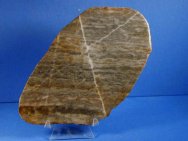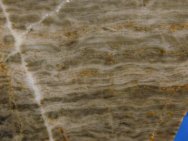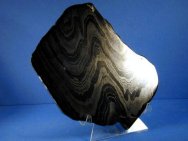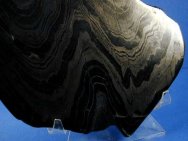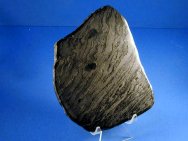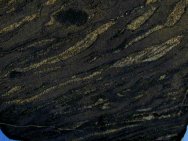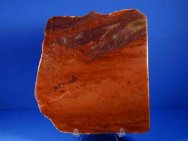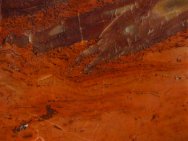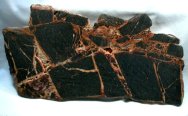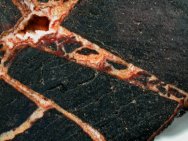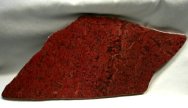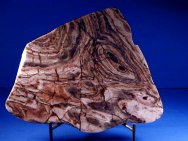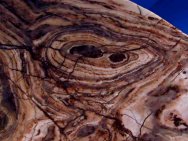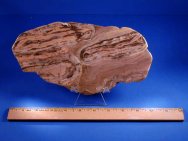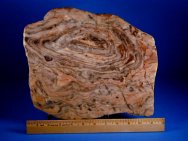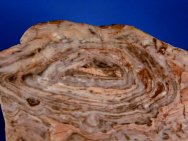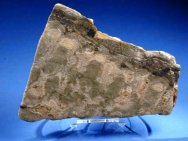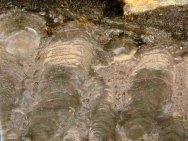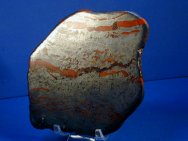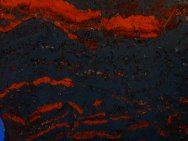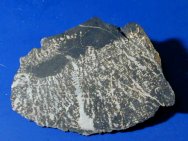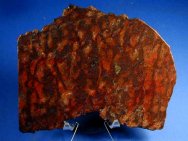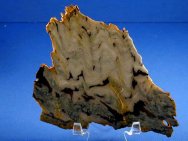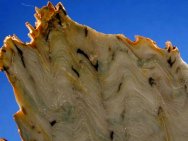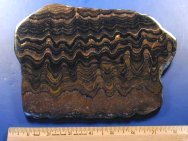| |
It
is common to think of Australia when stromatolites are mentioned
owing to the famous Shark Bay living stromatolites, as well as
the bacterial microfossils and molecular fossils found in inland
Australia that date to before 3 billion years ago. In fact, however,
American North, South and Central) has numerous outcrops of stromatolites
spanning across the continent as well as geological time. Older
stromatolites are particularly abundant in the Northern states
of Wisconsin, Michigan and Minnesota dating from about the upper
Archaean to the Lower Proterozoic, including expansive banded
iron formations that stand as testament to the rusting of the
earth.
The
American stromatolites image gallery below has specimens that
have been cut and polished to a mirror finish. While rough stromatolites
are generally dull and unremarkable in appearance, the fine polishing
renders the inherent beauty of the oldest fossils on earth, including
a myriad of colors and much variation in form genera and lamination
structure.
Archaean
Stromatolites |
|
|
|
|
Hadrophycus
immanus Stromatolites
Archaean (2.58 billion years old)
Libby Super Group, Nash Fork Shear Zone, Libby Flats Medicine
Bow Range, Wyoming |
Banded
Iron Stromatolites
Archaean
(2.87 billion years old)
Goldman Meadows Formation, Atlantic City Iron Mine, South
Pass, Wyoming |
|
|
|
|
| Banded
Iron Stromatolites
Archaean
(2.73 billion years old)
Jackson County Iron Formation in Wisconsin |
Stratifera
form genera Stromatolites
Archaean (>2.58 billion years old)
Lower Whalen Group, Hartville Uplift, near Guernsey, Wyoming
|
|
|
|
|
Brecciated
Banded Iron Stromatolites
Archaean
(2.73 billion years old)
Jackson County Iron Formation in Wisconsin |
|
|
Proterozoic
Stromatolites |
|
|
|
|
Lower
Proterozoic (2.2 to 2.4 billion years old)
Chocolay Group, Chocolay Hills, Northern Michigan |
Lower
Proterozoic (2.2 to 2.4 billion years old)
Chocolay Group, Chocolay Hills, Northern Michigan |
|
|
|
|
Lower
Proterozoic (2.2 to 2.4 billion years old)
Chocolay Group, Chocolay Hills, Northern Michigan
This specimen is interesting in that it
exhibits both flat and wavy lamination outside the Girvanella
form, and there are red blotches that are precipitated
Rhodochrosite. |
Gunflint
Stomatolites (1.9 billion)
Gunflint Formation, Ontario, Canada
In the March 7, 2002 edition of Nature (Volume 406), J.W.
Schopf, himself famous for his role in the discovery of
Domain of Life Archaea, reported discovery of cellular
remains of prokaryotic cells in the Gun Flint stromatolite.
Note the intricate domal layers of this chertized (Chert
is cryptocrystalized quartz) stromatolite that represents
a piece of history in the study of Pre-Cambrian paleobiology.
|
|
|
|
|
Banded
Iron (2.1 billion)
Upper Michigan
|
Newlandia
concentrica (2.0 billion)
Greyson Shale, Big Belt Mountains, Montana
Walcott described and named this strange
and unique (i.e., problematic) stromatolite in 1914 |
Collenia
undosa (2.3 billion)
Biwabik Formation, Mary Ellen Mine, Mesabi Range, St.
Louis County, Minnesota
Also called Mary Ellen Jasper, it is often
used to make jewelry |
|
|
|
|
From
Alaska (age unknown), where it
occasionally washes ashore and is collected by the Inuit
Native Americans. |
Lower
Proterozoic (2.4 billion)
Bad River Dolomite, Bayfield County, Wisconsin |
Lower
Proterozic (2.3 billion)
Eastern Andies South of Cochabamba, District of Cochabamba,
Bolivia, South America |
| | Stromatolites
Images by Marlene Garo |
| | |

